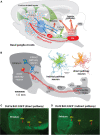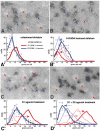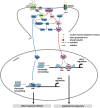Segregation of D1 and D2 dopamine receptors in the striatal direct and indirect pathways: An historical perspective
- PMID: 36741471
- PMCID: PMC9892636
- DOI: 10.3389/fnsyn.2022.1002960
Segregation of D1 and D2 dopamine receptors in the striatal direct and indirect pathways: An historical perspective
Abstract
The direct and indirect striatal pathways form a cornerstone of the circuits of the basal ganglia. Dopamine has opponent affects on the function of these pathways due to the segregation of the D1- and D2-dopamine receptors in the spiny projection neurons giving rise to the direct and indirect pathways. An historical perspective is provided on the discovery of dopamine receptor segregation leading to models of how the direct and indirect affect motor behavior.
Keywords: Parkinson’s disease; basal ganglia; dopamine; motor function; striatum.
Copyright © 2023 This work is authored by Charles R. Gerfen on behalf of the U.S. Government and as regards Dr. Gerfen, and the U.S. Government, is not subject to copyright protection in the United States. Foreign and other copyrights may apply.
Conflict of interest statement
The author declares that the research was conducted in the absence of any commercial or financial relationships that could be construed as a potential conflict of interest.
Figures







Similar articles
-
Dopaminergic treatment weakens medium spiny neuron collateral inhibition in the parkinsonian striatum.J Neurophysiol. 2017 Mar 1;117(3):987-999. doi: 10.1152/jn.00683.2016. Epub 2016 Dec 7. J Neurophysiol. 2017. PMID: 27927785 Free PMC article.
-
Homogeneous processing in the striatal direct and indirect pathways: single body part sensitive type IIb neurons may express either dopamine receptor D1 or D2.Eur J Neurosci. 2017 Oct;46(8):2380-2391. doi: 10.1111/ejn.13690. Epub 2017 Oct 4. Eur J Neurosci. 2017. PMID: 28887882 Free PMC article.
-
Striosomes Target Nigral Dopamine-Containing Neurons via Direct-D1 and Indirect-D2 Pathways Paralleling Classic Direct-Indirect Basal Ganglia Systems.bioRxiv [Preprint]. 2024 Jul 23:2024.06.01.596922. doi: 10.1101/2024.06.01.596922. bioRxiv. 2024. PMID: 38915684 Free PMC article. Preprint.
-
Modulation of striatal projection systems by dopamine.Annu Rev Neurosci. 2011;34:441-66. doi: 10.1146/annurev-neuro-061010-113641. Annu Rev Neurosci. 2011. PMID: 21469956 Free PMC article. Review.
-
Pathophysiology of Parkinson's disease: the MPTP primate model of the human disorder.Ann N Y Acad Sci. 2003 Jun;991:199-213. doi: 10.1111/j.1749-6632.2003.tb07477.x. Ann N Y Acad Sci. 2003. PMID: 12846988 Review.
Cited by
-
Dopamine Dysregulation in Reward and Autism Spectrum Disorder.Brain Sci. 2024 Jul 22;14(7):733. doi: 10.3390/brainsci14070733. Brain Sci. 2024. PMID: 39061473 Free PMC article. Review.
-
Dopaminergic Input Regulates the Sensitivity of Indirect Pathway Striatal Spiny Neurons to Brain-Derived Neurotrophic Factor.Biology (Basel). 2023 Oct 23;12(10):1360. doi: 10.3390/biology12101360. Biology (Basel). 2023. PMID: 37887070 Free PMC article.
-
Characterizing drug-induced stuttering in electronic health records.J Commun Disord. 2025 Jan-Feb;113:106475. doi: 10.1016/j.jcomdis.2024.106475. Epub 2024 Nov 19. J Commun Disord. 2025. PMID: 39615072 Free PMC article.
-
Chst9 marks a spatially and transcriptionally unique population of Oprm1-expressing neurons in the nucleus accumbens.Addict Neurosci. 2024 Jun;11:100153. doi: 10.1016/j.addicn.2024.100153. Epub 2024 Apr 18. Addict Neurosci. 2024. PMID: 38957401 Free PMC article.
-
Cognitive Functions, Neurotransmitter Alterations, and Hippocampal Microstructural Changes in Mice Caused by Feeding on Western Diet.Cells. 2023 Sep 21;12(18):2331. doi: 10.3390/cells12182331. Cells. 2023. PMID: 37759553 Free PMC article.
References
-
- Anderson M. E., Inase M., Buford J., Turner R. S., Mano N., Hamada I., et al. (1993). “Movement and preparatory activity of neurons in pallidal-receiv ing areas of the monkey thalamus,” in Role of the cerebellum and basal ganglia in voluntary movement, (Amsterdam: Elsevier Science Publishers; ).
Publication types
LinkOut - more resources
Full Text Sources

